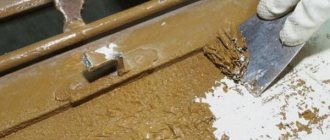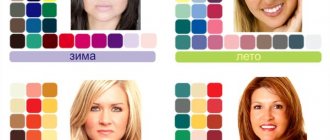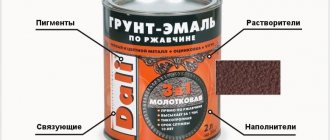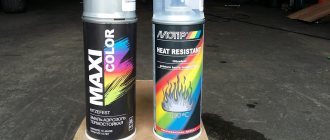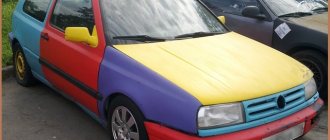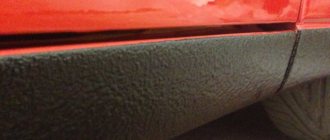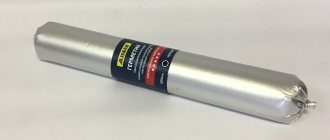- Where is the VIN code?
- Decoding
- How to find out the paint color of a car by VIN code
- Determination of paintwork online
- Determining paint color offline
- Where is the paint code indicated on different brands of cars?
- Code table for commonly used paint colors
- What to consider when choosing auto paint
If the paintwork of a car is damaged to a minor extent (chip, scratch), then it makes sense to restore only the area of the body where the defect appeared. But here it is important to accurately guess the color that will be used for repairs.
Today there are a huge number of colors and shades of body varnishes, and if you don’t guess the shade, you will have to repaint the entire car, and this is expensive and difficult. Therefore, it is very important to choose the exact number (code) of the paintwork, for which you will need the VIN code of the car.
Where is the VIN code?
A VIN code is a unique combination of Latin letters and Arabic numbers that is assigned to each vehicle. From it you can find out the main characteristics of the car, including the paint number.
Most manufacturers indicate both the VIN and the paint code on the vehicle and in the PTS (color name without code). Therefore, it is better to check the information on the body and decipher it correctly: the paint number and the required shade will be indicated there.
On different cars, the VIN code is located in different parts of the car. For new cars, information about the VIN code will be provided to you by dealers; for used cars, you will have to look for the nameplate yourself.
Traditional nameplate with VIN code can be located:
- at the center pillar on the driver's side;
- under any seat (passenger or driver);
- on the windshield (in the lower left part in a special window);
- at the bottom of the trunk;
- under the hood.
Note! During theft and major repairs, the car may be completely repainted, and its color will not match the factory one. Therefore, when buying a used car, always check these parameters.
How to use the VIN code to find the information you are interested in?
A VIN code is not a simple combination of numbers and letters. Any part of it contains useful data about the vehicle. Next are symbols that will tell you which plant the car was produced at. Then there are symbols containing information about the gearbox, body, model, engine and specification. The remaining characters provide the following data: what year the car was produced and its serial number.
Using the VIN code, you can read information from any car, regardless of its manufacturer: domestic or foreign. But there are exceptions - cars that are more than 30 years old . Previously, this marking was simply not used. It is also possible to find paintwork for such cars, but using other methods.
Decoding
VIN code is a set of characters in which all information on the car is encrypted:
- The initial three digits (WMI) indicate the manufacturer: place of production and country of origin.
- The next 5 characters indicate the model, body style, specification, transmission and engine.
- The next character is a control character and does not carry separate information.
- The tenth character determines the year of manufacture of the car.
- The eleventh is the assembly plant where the car was produced.
- The last 6 characters are the serial number of the machine.
Why is this necessary?
A responsible car owner is always interested in maintaining the ideal appearance of his vehicle. This also applies to its technical condition. When a car gets into unpleasant situations such as accidents, traffic accidents, or runs into various obstacles, the appearance of the car deteriorates significantly. Even high-quality body work during restoration will not allow the paint layer to be preserved in the form it had before the accident. Needs repainting. Also, the paint can simply fade, wear off, and scratches and chips periodically appear on the body. All this forces the owner to paint over the defects. Sometimes only a small area of the body is processed. In other, more serious situations, it is necessary to carry out a full cycle of repainting the vehicle.
There's only one problem. It lies in how to accurately select the paint. Yes, if this is a complete repainting, no one bothers you to change the shade or even color. But when partially restoring the paint layer, a shade that exactly matches the rest of the body is required. If you try to select paint by eye, about 90% of such attempts will lead to an error. It is important to understand that there can be a lot of identical colors in appearance. But many of them give slightly different shades after drying. As a result, in contrast with other parts of the body, this becomes very noticeable.
Some do things differently. Often, car owners remove an element of the car, mainly the gas tank cap, and go to the store, comparing it with the paints on offer. The method is not the worst, but even here there is a high probability of making a mistake when choosing. You can also refer to the technical documentation of the vehicle. Although often it only indicates a specific color without shades or any special codes. Still, we must not forget that one color has several dozen shades. And depending on the paint manufacturer, its texture may differ. You shouldn’t give up and buy the first can you come across. There is a great way to check and reliably find out the color number of a car using the VIN code.
How to find out the paint color of a car by VIN code
It is not possible to find out the color of a car directly by the VIN code - you only receive detailed information about the model, year of manufacture and factory equipment. But it is this information that allows us to establish a list of paintwork materials that were used specifically for this model during production.
Determination of paintwork online
Knowing the VIN number, you can get information online about the color and shade of the car’s “original” paint. There are several ways to do this:
- Determine the paint code by VIN through the car manufacturer's website. The information will be among the technical information about the car.
- Use specialized search services (Autohistory, Autocode, etc.). Here you also need to enter your VIN code and order a report by email. There is a fee for checking.
- Contact online car paint stores that produce professional computer paint selection based on VIN number. You can also order paint here.
Determining paint color offline
You can find out the car body color yourself:
- Contact your dealer directly.
- Consult a service station (but you will need experienced specialists and modern equipment).
What is a car's VIN?
The VIN number is unique alphanumeric information. Only Latin letters are used. Each vehicle has a unique VIN and is assigned to the vehicle by the manufacturer. In addition to uniqueness, the VIN code carries data about the main characteristics of the car.
The VIN number of the vehicle is written in its passport
Using the VIN code you can find a lot of useful information for your car. You can select any compatible spare parts, find out the paint color, check for fines or arrests.
Where is the paint code indicated on different brands of cars?
The paint code is located in different places on the nameplate.
- For German and Korean vehicles, this is the left side.
- For French cars it is on the right.
- For American and Japanese cars - in the lower part.
Important Tips
Please note that it is not always possible to purchase a ready-made can of paint that will completely match the enamel shade of your body. Here it is better to contact an experienced and trusted colorist. This is the name given to specialists involved in the production of paints. Colorists usually only need the code. Using it, he can easily recreate the composition that was used to cover the body of your particular vehicle. But sometimes additional information is required in the form of the car model name and year of manufacture. Based on this information, the colorist can easily find a list of enamels that were used to coat cars of this model in a certain year of production. All information is publicly available, and therefore there is no need to carry out any complex search activities.
It is a mistake to believe that the VIN code serves solely to identify the car, its manufacturer, year of manufacture and other technical information. It contains a large amount of extremely useful data, including the number of the enamel used when painting the machine. Do not forget about the need to strictly adhere to all coloring rules. If the car requires serious repairs, and the paint layer is restored completely, or over a large area, it is better to contact good specialists who have special boxes at their disposal for these purposes. Their colorist will help with the production of paint, and the dyeing process itself will be carried out in the conditions that best meet all requirements.
If the defects are small, you can easily handle the task of restoring the paintwork yourself. To do this, you need to prepare an area of the body for painting, remove all dirt, remaining peeling paint, and degrease the surface. We must not forget about the likelihood of corrosion if the metal was damaged or even slightly deformed upon impact. Here it is better to immediately do anti-corrosion treatment, apply primer and then use the right paint.
Even when painting a small part of the body, the car must dry completely. Therefore, it is not recommended to drive it out of the garage for 2–3 days after completion of the work. Also avoid washing with high pressure water. By following all these rules, you will be able to maintain all the protective properties of the new enamel, and you will also be able to restore the paint layer so that the damaged area is no different from the color of the rest of the body elements.
What to consider when choosing auto paint
If we are talking about a used car, it is very important to determine whether it has been completely repainted in order to eliminate the risk of purchasing a “criminal” vehicle. In addition, you need to remember several important rules for choosing paintwork:
- If the former owner changed the color completely, then most likely non-factory paint was used. Therefore, the information obtained by VIN code will be irrelevant, and the color of the existing coating in different places of the body should be compared.
- You can use a paint thickness gauge. Not a single technician at a service station will paint a car as efficiently as they do at the factory. Therefore, the amount of paintwork applied will most likely differ in different places on the body (if the car has been repainted).
- Paint changes its properties over time due to natural conditions. In this case, the shade of the coating in different places of the body will also differ from the original tone according to the VIN code.
- To minimize the risk of choosing the wrong shade, you can turn to spectral paint selection, which allows you to select the right pigments for the paint composition.
- It should be borne in mind that many car manufacturing plants use paintwork that is not commercially available. In such a situation, it will be difficult to find the right color, even if you accurately determine the shade. You will need the services of a professional computer selection of the closest possible shade.
- If the car is more than 10 years old, then the paintwork has most likely already been discontinued. In such a situation, it is also necessary to use complex techniques for selecting and mixing paint colors.
So, using the VIN number it is quite convenient to select the correct paintwork for the car. However, it is good for new and popular car models. With old and repainted vehicles, this method is not always convenient and effective.
To minimize the risk of error, it is better to turn to professionals or request the necessary information directly from the dealer.
What is a VIN code, and how can you use it to find out the paint number of a car?
A VIN code is an individual number of your vehicle, which contains data about its specific parameters (country of manufacture, engine type, body type, assembly, model number, etc.). The main purpose of assigning a VIN code is to protect against theft. Therefore, in accordance with the rules of the ISO 3779 standard, the VIN code printed on a metal plate must be installed in such a way that it cannot be removed without causing irreparable damage to the vehicle. Thus, the VIN code is present on all cars until they are scrapped. Finding the VIN is easy. In most cases, manufacturers attach it in the following places:
- on the front of the engine;
- on the frame of one of the front doors;
- on the steering column;
- on the inner arch of the front wheel;
- on the dashboard near the windshield;
- on the radiator bracket;
- on the thermal insulation partition.
Video where to look for the VIN code or body number of a car:
You can also find out the VIN code from the car documents. It is displayed in the car’s registration certificate, in its warranty card, in the technical inspection card, in the car insurance.
The VIN code consists of seventeen characters (numbers and Latin letters) and is divided into three main sections.
- WMI part. Contains information about the manufacturer. Each manufacturer has a three-digit code consisting of certain letters and numbers.
- WDS part. This is the vehicle description section. This includes characters four through nine. They encrypt data about the type of vehicle, its chassis, body type, model number, etc.
- The third section includes eight characters from ten to seventeen. This is an identification section that contains information about installed parts, engine, gearbox. The last six digits are the vehicle series number, and the last four characters must be strictly numeric.
Having found out the VIN code of your car, you can act in several ways in order to determine the color of the car from it:
- Contact an authorized dealer to determine the paint tone. To do this, you will need to provide him with a VIN code and indicate the make of the car. After which, in a fairly short time, you will receive complete information about your car and its color number.
Advice: you can contact the dealer directly by coming to the showroom, but to save effort and time, it is better to contact him by phone or email.
- Contact a car tinting specialist at a car service center. Using a special program, he will decipher the VIN code you provided and find out the color number that your car was originally painted with.
- You can personally find the necessary program for decoding the VIN code on the Internet. Use it to find out the color of your car.
Thus, it becomes clear that in order to repair a car with subsequent painting, you need to know the exact color of your vehicle and the VIN code will be the most helpful. You should not determine the color of the car, as they say, “by eye,” as this may lead to you having to repaint it.
Of course, even knowing the exact color that your car originally had does not provide a 100% guarantee that the color of the painted part will not differ from the rest of the body. To make this difference as less noticeable as possible, remember that:
- Tinting machines from different vintages may vary shades, so always do a test color match.
- It is necessary to compare shades in different lighting conditions, since sunlight and light from artificial lighting sources have the ability to be reflected differently from the surface of objects.
- With prolonged use, the paint on the body has a certain degree of fading, so the color of the car will differ slightly from its original tone.
- The color of the paint can change after drying.
- You only need to contact experienced colorists about whom you have good reviews.
Video: how to determine the paint color of a car
- How to choose a car color
- How to install a navigator on a tablet
- Tips for transporting a bicycle in a car
- Rear view camera: mirror, wireless, framed
Editor's note: 6 reasons to open a snack bar on wheels
How to determine the VIN code
To understand how to determine the VIN number for a VAZ car, you need to know where it is located. Even international standards do not require the placement of a VIN code. You can usually find the enamel code for a car in the following ways:
- finding it on the body. The surest way to find out the color code is to look for its presence on the pillars near the driver’s seat, in the windshield area, in the engine compartment, under the trunk;
- "approximately". The least accurate way to determine the shade of the body, which is unlikely to be suitable for partial repainting of the car;
- using specialized sites. There you can search for the composition by code, or, if you don’t know where to look for the color by VIN code, a special field is presented. There you enter the year of manufacture of the car and its model, and the search helps determine the composition code;
